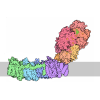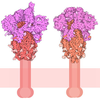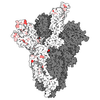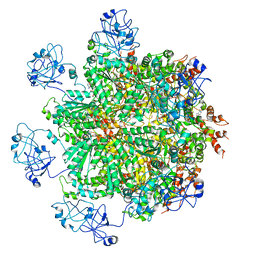+ Open data
Open data
- Basic information
Basic information
| Entry |  | |||||||||
|---|---|---|---|---|---|---|---|---|---|---|
| Title | p97 (VCP) double mutant - F266A F539A | |||||||||
 Map data Map data | Post-processed map | |||||||||
 Sample Sample |
| |||||||||
 Keywords Keywords | Hexameric complex / ATPase / Unfoldase / Protein Quality Control / Segregase / CHAPERONE | |||||||||
| Function / homology |  Function and homology information Function and homology information: / flavin adenine dinucleotide catabolic process / VCP-NSFL1C complex / endosome to lysosome transport via multivesicular body sorting pathway / endoplasmic reticulum stress-induced pre-emptive quality control / BAT3 complex binding / cellular response to arsenite ion / protein-DNA covalent cross-linking repair / cytoplasm protein quality control / Derlin-1 retrotranslocation complex ...: / flavin adenine dinucleotide catabolic process / VCP-NSFL1C complex / endosome to lysosome transport via multivesicular body sorting pathway / endoplasmic reticulum stress-induced pre-emptive quality control / BAT3 complex binding / cellular response to arsenite ion / protein-DNA covalent cross-linking repair / cytoplasm protein quality control / Derlin-1 retrotranslocation complex / positive regulation of protein K63-linked deubiquitination / positive regulation of oxidative phosphorylation / : / aggresome assembly / deubiquitinase activator activity / regulation of protein localization to chromatin / ubiquitin-modified protein reader activity / mitotic spindle disassembly / VCP-NPL4-UFD1 AAA ATPase complex / cellular response to misfolded protein / negative regulation of protein localization to chromatin / vesicle-fusing ATPase / positive regulation of mitochondrial membrane potential / K48-linked polyubiquitin modification-dependent protein binding / regulation of aerobic respiration / retrograde protein transport, ER to cytosol / stress granule disassembly / regulation of synapse organization / ATPase complex / ubiquitin-specific protease binding / MHC class I protein binding / positive regulation of ATP biosynthetic process / ubiquitin-like protein ligase binding / RHOH GTPase cycle / polyubiquitin modification-dependent protein binding / autophagosome maturation / endoplasmic reticulum to Golgi vesicle-mediated transport / negative regulation of hippo signaling / HSF1 activation / translesion synthesis / interstrand cross-link repair / proteasomal protein catabolic process / ATP metabolic process / Protein methylation / endoplasmic reticulum unfolded protein response / Attachment and Entry / Josephin domain DUBs / ERAD pathway / lipid droplet / N-glycan trimming in the ER and Calnexin/Calreticulin cycle / proteasome complex / viral genome replication / Hh mutants are degraded by ERAD / Hedgehog ligand biogenesis / Defective CFTR causes cystic fibrosis / Translesion Synthesis by POLH / negative regulation of smoothened signaling pathway / macroautophagy / positive regulation of protein-containing complex assembly / ABC-family proteins mediated transport / establishment of protein localization / positive regulation of non-canonical NF-kappaB signal transduction / ADP binding / autophagy / Aggrephagy / Ovarian tumor domain proteases / KEAP1-NFE2L2 pathway / cytoplasmic stress granule / positive regulation of protein catabolic process / azurophil granule lumen / E3 ubiquitin ligases ubiquitinate target proteins / positive regulation of canonical Wnt signaling pathway / positive regulation of proteasomal ubiquitin-dependent protein catabolic process / site of double-strand break / double-strand break repair / Neddylation / cellular response to heat / ubiquitin-dependent protein catabolic process / protein phosphatase binding / secretory granule lumen / regulation of apoptotic process / proteasome-mediated ubiquitin-dependent protein catabolic process / ficolin-1-rich granule lumen / Attachment and Entry / protein ubiquitination / ciliary basal body / protein domain specific binding / DNA repair / intracellular membrane-bounded organelle / ubiquitin protein ligase binding / lipid binding / DNA damage response / endoplasmic reticulum membrane / Neutrophil degranulation / perinuclear region of cytoplasm / glutamatergic synapse / endoplasmic reticulum / protein-containing complex / ATP hydrolysis activity / RNA binding Similarity search - Function | |||||||||
| Biological species |  Homo sapiens (human) Homo sapiens (human) | |||||||||
| Method | single particle reconstruction / cryo EM / Resolution: 3.4 Å | |||||||||
 Authors Authors | Arie M / Matzov D / Karmona R / Szenkier N / Stanhill A / Navon A | |||||||||
| Funding support |  Israel, 1 items Israel, 1 items
| |||||||||
 Citation Citation |  Journal: Iscience / Year: 2024 Journal: Iscience / Year: 2024Title: A non-symmetrical p97 conformation initiates a multistep recruitment of Ufd1/Npl4. Authors: Arie M / Matzov D / Karmona R / Szenkier N / Stanhill A / Navon A | |||||||||
| History |
|
- Structure visualization
Structure visualization
- Downloads & links
Downloads & links
-EMDB archive
| Map data |  emd_19473.map.gz emd_19473.map.gz | 79 MB |  EMDB map data format EMDB map data format | |
|---|---|---|---|---|
| Header (meta data) |  emd-19473-v30.xml emd-19473-v30.xml emd-19473.xml emd-19473.xml | 19.9 KB 19.9 KB | Display Display |  EMDB header EMDB header |
| Images |  emd_19473.png emd_19473.png | 55.3 KB | ||
| Filedesc metadata |  emd-19473.cif.gz emd-19473.cif.gz | 6.3 KB | ||
| Others |  emd_19473_additional_1.map.gz emd_19473_additional_1.map.gz emd_19473_half_map_1.map.gz emd_19473_half_map_1.map.gz emd_19473_half_map_2.map.gz emd_19473_half_map_2.map.gz | 41.4 MB 77.4 MB 77.4 MB | ||
| Archive directory |  http://ftp.pdbj.org/pub/emdb/structures/EMD-19473 http://ftp.pdbj.org/pub/emdb/structures/EMD-19473 ftp://ftp.pdbj.org/pub/emdb/structures/EMD-19473 ftp://ftp.pdbj.org/pub/emdb/structures/EMD-19473 | HTTPS FTP |
-Validation report
| Summary document |  emd_19473_validation.pdf.gz emd_19473_validation.pdf.gz | 1.1 MB | Display |  EMDB validaton report EMDB validaton report |
|---|---|---|---|---|
| Full document |  emd_19473_full_validation.pdf.gz emd_19473_full_validation.pdf.gz | 1.1 MB | Display | |
| Data in XML |  emd_19473_validation.xml.gz emd_19473_validation.xml.gz | 13 KB | Display | |
| Data in CIF |  emd_19473_validation.cif.gz emd_19473_validation.cif.gz | 15.5 KB | Display | |
| Arichive directory |  https://ftp.pdbj.org/pub/emdb/validation_reports/EMD-19473 https://ftp.pdbj.org/pub/emdb/validation_reports/EMD-19473 ftp://ftp.pdbj.org/pub/emdb/validation_reports/EMD-19473 ftp://ftp.pdbj.org/pub/emdb/validation_reports/EMD-19473 | HTTPS FTP |
-Related structure data
| Related structure data | 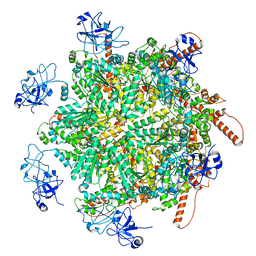 8rs9MC 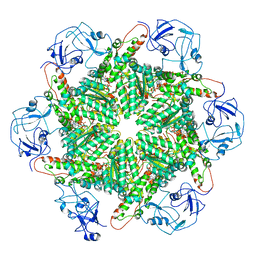 8pqxC 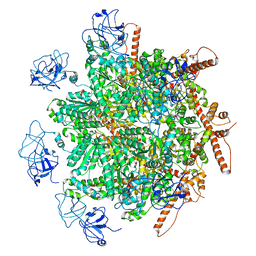 8r0eC  8rsbC  8rscC M: atomic model generated by this map C: citing same article ( |
|---|---|
| Similar structure data | Similarity search - Function & homology  F&H Search F&H Search |
- Links
Links
| EMDB pages |  EMDB (EBI/PDBe) / EMDB (EBI/PDBe) /  EMDataResource EMDataResource |
|---|---|
| Related items in Molecule of the Month |
- Map
Map
| File |  Download / File: emd_19473.map.gz / Format: CCP4 / Size: 83.7 MB / Type: IMAGE STORED AS FLOATING POINT NUMBER (4 BYTES) Download / File: emd_19473.map.gz / Format: CCP4 / Size: 83.7 MB / Type: IMAGE STORED AS FLOATING POINT NUMBER (4 BYTES) | ||||||||||||||||||||
|---|---|---|---|---|---|---|---|---|---|---|---|---|---|---|---|---|---|---|---|---|---|
| Annotation | Post-processed map | ||||||||||||||||||||
| Voxel size | X=Y=Z: 0.86 Å | ||||||||||||||||||||
| Density |
| ||||||||||||||||||||
| Symmetry | Space group: 1 | ||||||||||||||||||||
| Details | EMDB XML:
|
-Supplemental data
- Sample components
Sample components
-Entire : Tertiary complex of the hexameric p97 F266A F539A double mutant
| Entire | Name: Tertiary complex of the hexameric p97 F266A F539A double mutant |
|---|---|
| Components |
|
-Supramolecule #1: Tertiary complex of the hexameric p97 F266A F539A double mutant
| Supramolecule | Name: Tertiary complex of the hexameric p97 F266A F539A double mutant type: complex / ID: 1 / Parent: 0 / Macromolecule list: all Details: The mutant generated by the replacement of phenylalanine to alanine at positions 266 and 539. |
|---|---|
| Source (natural) | Organism:  Homo sapiens (human) Homo sapiens (human) |
| Molecular weight | Theoretical: 530 KDa |
-Macromolecule #1: Transitional endoplasmic reticulum ATPase
| Macromolecule | Name: Transitional endoplasmic reticulum ATPase / type: protein_or_peptide / ID: 1 / Number of copies: 6 / Enantiomer: LEVO / EC number: vesicle-fusing ATPase |
|---|---|
| Source (natural) | Organism:  Homo sapiens (human) Homo sapiens (human) |
| Molecular weight | Theoretical: 89.284633 KDa |
| Recombinant expression | Organism:  |
| Sequence | String: MASGADSKGD DLSTAILKQK NRPNRLIVDE AINEDNSVVS LSQPKMDELQ LFRGDTVLLK GKKRREAVCI VLSDDTCSDE KIRMNRVVR NNLRVRLGDV ISIQPCPDVK YGKRIHVLPI DDTVEGITGN LFEVYLKPYF LEAYRPIRKG DIFLVRGGMR A VEFKVVET ...String: MASGADSKGD DLSTAILKQK NRPNRLIVDE AINEDNSVVS LSQPKMDELQ LFRGDTVLLK GKKRREAVCI VLSDDTCSDE KIRMNRVVR NNLRVRLGDV ISIQPCPDVK YGKRIHVLPI DDTVEGITGN LFEVYLKPYF LEAYRPIRKG DIFLVRGGMR A VEFKVVET DPSPYCIVAP DTVIHCEGEP IKREDEEESL NEVGYDDIGG CRKQLAQIKE MVELPLRHPA LFKAIGVKPP RG ILLYGPP GTGKTLIARA VANETGAFAF LINGPEIMSK LAGESESNLR KAFEEAEKNA PAIIFIDELD AIAPKREKTH GEV ERRIVS QLLTLMDGLK QRAHVIVMAA TNRPNSIDPA LRRFGRFDRE VDIGIPDATG RLEILQIHTK NMKLADDVDL EQVA NETHG HVGADLAALC SEAALQAIRK KMDLIDLEDE TIDAEVMNSL AVTMDDFRWA LSQSNPSALR ETVVEVPQVT WEDIG GLED VKRELQELVQ YPVEHPDKFL KFGMTPSKGV LFYGPPGCGK TLLAKAIANE CQANAISIKG PELLTMWFGE SEANVR EIF DKARQAAPCV LFFDELDSIA KARGGNIGDG GGAADRVINQ ILTEMDGMST KKNVFIIGAT NRPDIIDPAI LRPGRLD QL IYIPLPDEKS RVAILKANLR KSPVAKDVDL EFLAKMTNGF SGADLTEICQ RACKLAIRES IESEIRRERE RQTNPSAM E VEEDDPVPEI RRDHFEEAMR FARRSVSDND IRKYEMFAQT LQQSRGFGSF RFPSGNQGGA GPSQGSGGGT GGSVYTEDN DDDLYG UniProtKB: Transitional endoplasmic reticulum ATPase |
-Experimental details
-Structure determination
| Method | cryo EM |
|---|---|
 Processing Processing | single particle reconstruction |
| Aggregation state | particle |
- Sample preparation
Sample preparation
| Concentration | 7 mg/mL | ||||||||||||
|---|---|---|---|---|---|---|---|---|---|---|---|---|---|
| Buffer | pH: 7.5 Component:
| ||||||||||||
| Grid | Model: Quantifoil R2/2 / Material: COPPER / Mesh: 200 / Support film - Material: CARBON / Support film - topology: HOLEY / Support film - Film thickness: 12 | ||||||||||||
| Vitrification | Cryogen name: ETHANE / Chamber humidity: 100 % / Chamber temperature: 277.15 K / Instrument: FEI VITROBOT MARK IV Details: pre-blotting incubation time of 20 secounds and blot for 3.5 seconds with -1 blot force. |
- Electron microscopy
Electron microscopy
| Microscope | FEI TITAN KRIOS |
|---|---|
| Image recording | Film or detector model: GATAN K3 (6k x 4k) / Number real images: 11902 / Average electron dose: 38.0 e/Å2 |
| Electron beam | Acceleration voltage: 300 kV / Electron source:  FIELD EMISSION GUN FIELD EMISSION GUN |
| Electron optics | Illumination mode: FLOOD BEAM / Imaging mode: BRIGHT FIELD / Cs: 2.7 mm / Nominal defocus max: 2.0 µm / Nominal defocus min: 0.8 µm |
| Sample stage | Cooling holder cryogen: NITROGEN |
| Experimental equipment |  Model: Titan Krios / Image courtesy: FEI Company |
 Movie
Movie Controller
Controller












